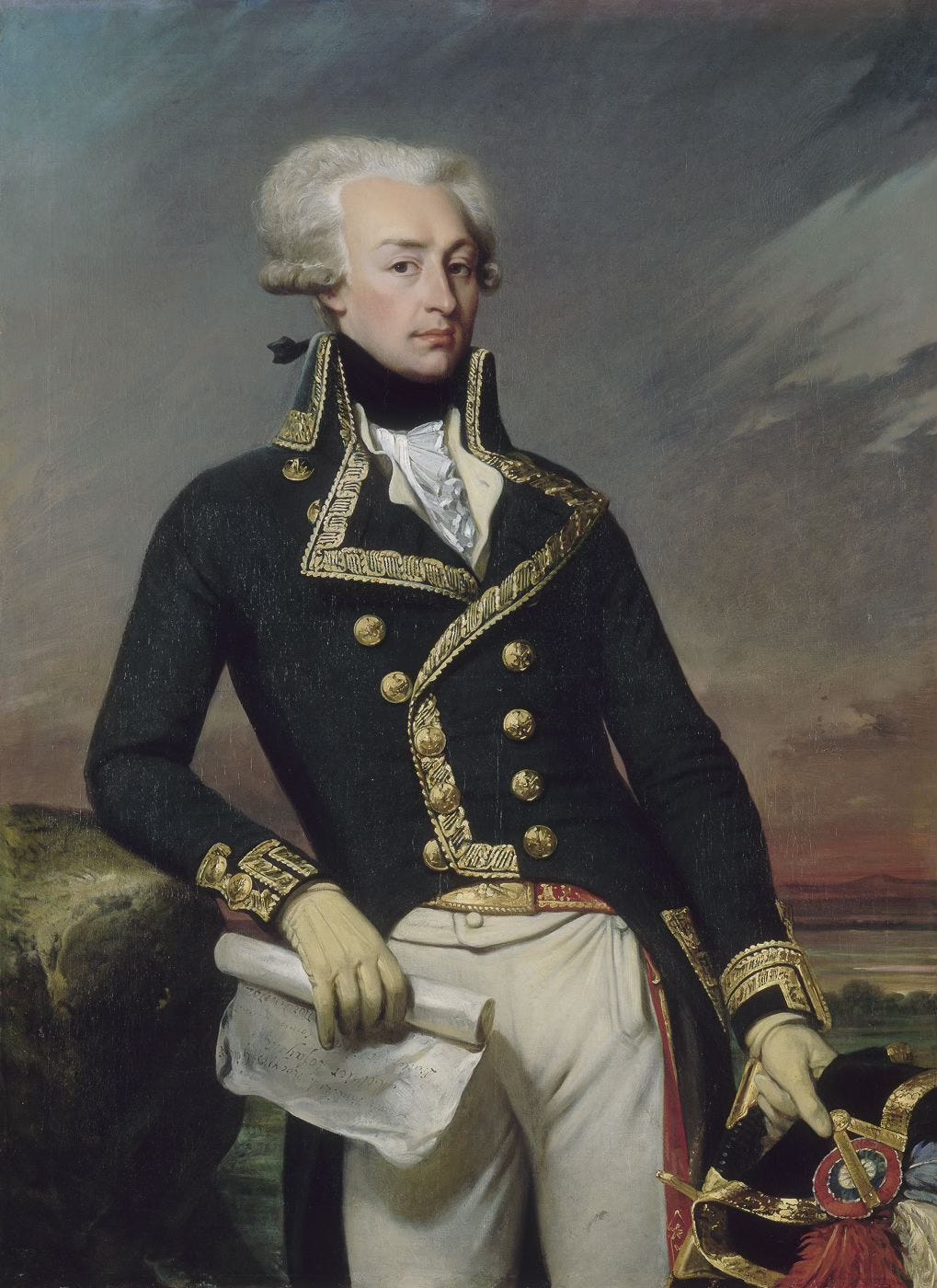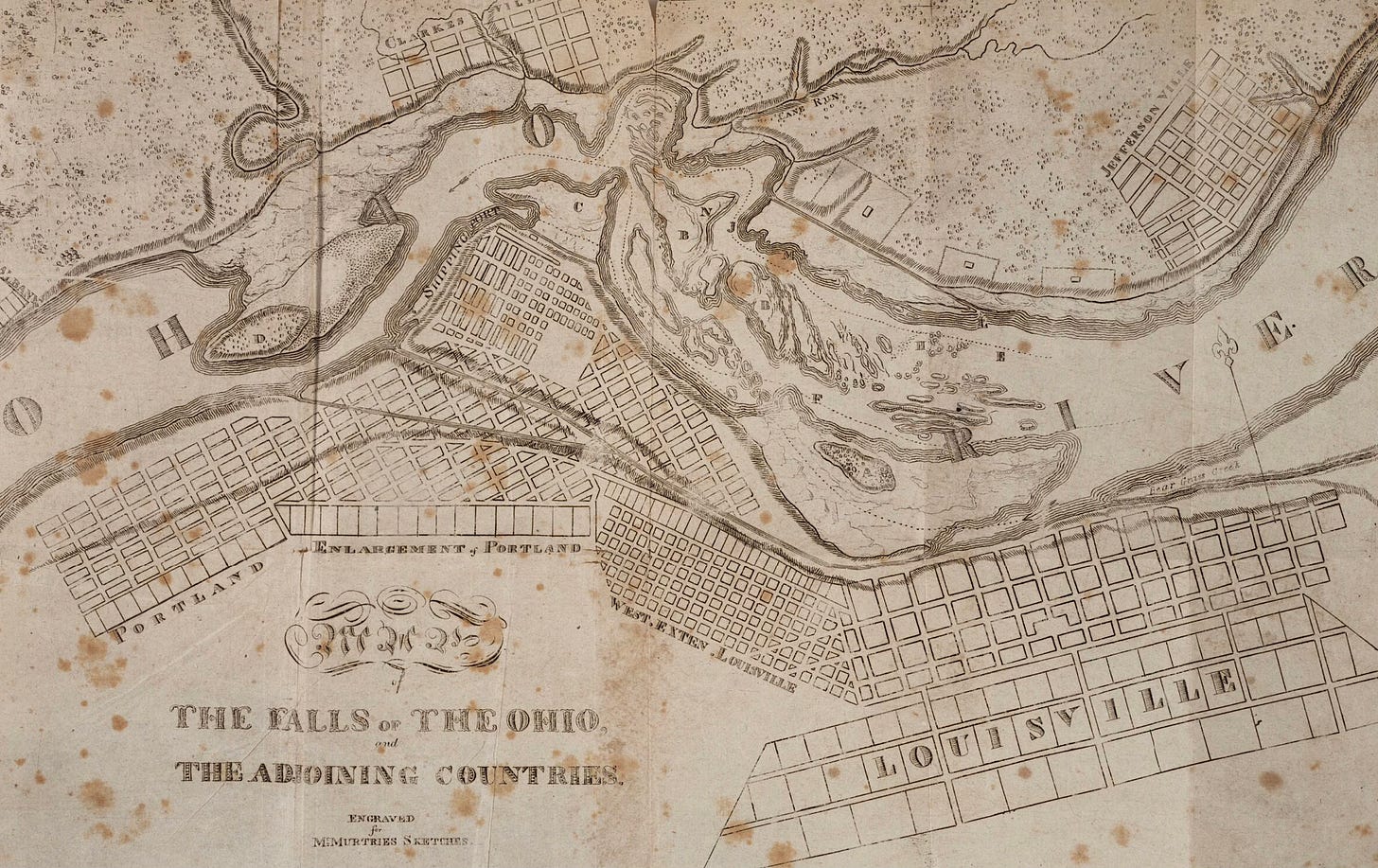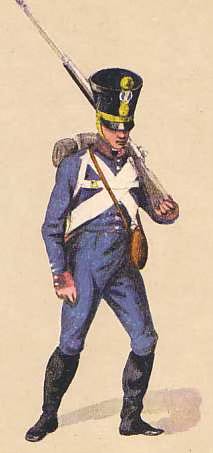The Shoemaker Who Might’ve Met Lafayette
One quiet man. One passing general. And a family story that still echoes through Louisville.
The crowds gathered early along the wharf. Steamboats hissed against the current, and the smell of river silt clung to the humid air. Clouds hung low, the sky heavy with the kind of quiet that comes before a storm. In Portland — not yet swallowed by Louisville, not yet forgotten by time — flags waved, children climbed barrels to see, and war veterans pulled their coats tighter against emotions they didn’t name.
Among them stood a man with worn hands and a quiet gaze: Rudolf Zweydorf, shoemaker by trade, soldier by memory. In his youth in Braunschweig, he had known the weight of a musket before the weight of fatherhood. The Napoleonic Wars had taken much from his generation — illusions, comrades, borders — and left behind silence. Now in Kentucky, in a bustling port town perched on the edge of the Ohio River, he watched as another soldier — a Frenchman, a legend — stepped ashore.
The Marquis de Lafayette.
He had come as a guest of the nation he helped birth, now in its fiftieth year. Rudolf had come as a refugee of the old world, building a new life one stitch, one sole, one family member at a time.
Did their eyes meet across the crowd? Did Rudolf, who had once marched beneath a different banner, feel kinship or curiosity? Was there reverence in that moment — or just recognition?
If Rudolf did not cheer, it wasn’t from disrespect. Far from it. But the celebration may have stirred something quieter. The children climbing barrels might have reminded him of a time when he, too, was small — before Europe was set ablaze by ambition and empire.
He had come from Braunschweig, a principality that stood proud until Napoleon’s forces swept through in 1806. The old Duke was killed. The young heir fled to Britain and vowed revenge. Some fought back as Black Brunswickers, donning foreign uniforms and dying in distant fields. Rudolf chose a different path. Like many young men from fractured German states, he moved south, into the orbit of Bavaria — and into the shadow of Napoleon.
By 1809, barely seventeen, Rudolf had likely been conscripted or swept into service. Bavaria, newly crowned a kingdom by Napoleon, owed him troops. Thousands of Bavarians marched under French command into Austria — and later, into the frozen hell of Russia. Whether Rudolf fought at Wagram or trudged through snowbound forests, we do not know. But we know he survived. And by 1824, that meant something.
He was a shoemaker by then. Perhaps he learned the trade on campaign — in every army, feet failed before courage did. Maybe he mended soles as often as he shouldered a musket. When Bavaria turned against Napoleon in 1813, joining the grand betrayal at Leipzig, Rudolf had likely had enough of shifting loyalties. Somewhere along the line, he made a decision: to cross an ocean and build something steady.
And so here he stood, in Portland, Kentucky, watching a general from another revolution — one who had seen the worst of war and still believed in the best of people — greeted with parades and cannon fire. Lafayette. The man who had stood with Washington. The man Napoleon both feared and admired.
A rumble of thunder echoed from the Indiana side. Storms had been moving up the river all week — and in the days ahead, hail the size of musket balls would pelt the rooftops of Louisville. But for now, the rain held off. The clouds, like the crowd, seemed to hold their breath.
Perhaps Rudolf saw something of himself in that weathered face. Or perhaps he saw what he wished he had fought for — not a crown, not a campaign, but an ideal.
We can’t know. But we do know this: Lafayette’s steamboat, Paragon, docked in Portland on May 11, 1825. And less than a year earlier, on August 5, 1824, Rudolf had welcomed the birth of a son named Leonidas — a name steeped in ancient resistance.
It was no accident. Rudolf had been raised in Braunschweig — the City of Lions. In that old German city, a bronze lion stands watch in the town square, proud and unbending. Perhaps he passed it daily as a boy, head tilted back, heart full of stories. Perhaps he carried its image through war, across borders, and into exile. Perhaps it reminded him who he was when the world tried to make him forget.
Years later, he would name his other son Louis — after King Louis XVI, for whom Louisville itself was named. One son named for the old world he left behind. One for the new world he hoped to build. Memory and hope, stitched into names.

To name his son Leonidas was to summon strength. It was to remember where he came from — and to hope for a future that wouldn’t break so easily. A lion for a son, in a world that took too much.
But Leonidas’s mother — Rudolf’s first wife — vanishes from the record soon after. Her name is lost. And Leonidas, too, disappears from every trace that follows. It’s possible, even likely, that both died in Louisville, a city then plagued by riverborne disease. Illnesses like cholera, typhoid, and malaria often swept through low-lying neighborhoods like Portland and Shippingport, taking lives without leaving records.
By May 1826, Rudolf had remarried — this time to Rosina Christine Dautt, a widow herself.
So when Lafayette came ashore in Portland, Rudolf may not have been cheering.
He may have been mourning.
And beginning again.
History leaves us gaps.
Family fills them with questions.
And in the quiet space between, we sometimes find stories that feel like truth.

Portland, the Shoemaker’s Town
Portland in 1825 wasn’t just a town. It was a boomtown. Positioned just west of the Falls of the Ohio, it served as a vital portage stop between the commerce of Pittsburgh and the grandeur of New Orleans. On one side of the falls: sugar and cotton. On the other: coal and the clamor of new cities. Portland stood between them — a crossroads of trade, language, and fate.

Rudolf Zweydorf arrived here not long after the wars that had upended Europe. He brought with him more than memories—he brought a trade honed in hardship. He likely lived first on Shippingport Island, an enclave of wealth and cultural exchange where French Creole customs mingled with German practicality. The island’s homes — some owned by former New Orleanians — rose on higher ground, though even they couldn’t escape the river’s moods.
Later, the Zweydorfs would settle on Bank Street, their name stitched into Portland’s daily life. As a cobbler, Rudolf would have known the feet of the community — laborers, boatmen, merchants, children — each one needing something mended, something made to last.
He had once marched to the beat of empire. Now, he measured life in stitches and soles.

Rosina’s Turn: From Harmony to Henderson
If Rudolf was shaped by war, Rosina Christine Dautt was shaped by conviction — and by loss.
In 1801, just two years old, she arrived at the Port of Philadelphia with her family—early charter members of the Harmony Society, a German pietist group chasing a utopian dream in the New World. Founded by George Rapp, the Society embraced a communal life rooted in hard work, religious devotion, and equality. Members renounced personal property and shared everything in common. They believed Christ’s return was imminent and that by purifying themselves—through labor, celibacy, and spiritual discipline—they could build a heaven on earth.
Their ideals were bold. They rejected the materialism of the age, invested in education, music, and industry, and built model communities that were orderly, clean, and surprisingly profitable. At one point, they even explored merging with the Shakers—another radical sect that practiced celibacy and communal life—though the union never materialized. Still, the very idea shows how committed they were to their vision of a pure, godly society.
And when they felt the world creeping in too close, they did something astonishing—they moved. Not once, but twice. First from Pennsylvania to the Indiana frontier, where they founded the town of New Harmony along the Wabash River. Then, years later, the remaining members packed up again and returned to Pennsylvania.
Rosina’s family left before that final return. When the Society’s leader demanded celibacy from all members—arguing it was necessary for spiritual purity—they walked away. It meant giving up the community they’d helped build, but they did it anyway. They resettled in Henderson, Kentucky, just south of New Harmony. And they made the right call—because if they hadn’t, I wouldn’t be here to tell you what happened next.
That choice—to abandon rigid ideals in favor of something real—would echo through Rosina’s own life of love, loss, and resilience.
There, in 1822, she married Philo Eddy. But within a short time, her husband and parents likely died in an epidemic. Her only child from that marriage, a boy named Lee, would later drown.
In 1826, she married Rudolf Zweydorf in the Methodist Episcopal Church—perhaps looking for steadiness, or someone who had also known grief and kept going.
Not long after, she wrote a letter to George Rapp, the Harmony Society’s founder, asking for compensation for the labor her father—a skilled joiner—had given the community. He had built their structures. Their homes. Their dream.
Rapp dismissed it as a “beggar’s letter.”
By August 1827, Rosina and Rudolf were in Wheeling, Virginia (now West Virginia), where their daughter Anna Mary was born. Why Wheeling? The records don’t say. But I believe they were searching for others like them—former Harmonists trying to start over.
Eventually, they returned to Louisville and made it home.
Children of the River and the Road
Rudolf and Rosina had four children: Anna Mary, Louis William, Lucinda, and Rebecca. Of them, Louis and Rebecca would carry forward a legacy that my grandmother passed on — one that still stirs something in me.
Louis William Zweydorff operated a hotel, saloon, and general store at Hancock and Jefferson in Louisville. During the Civil War, Union soldiers passed through his doors. His sister Rebecca married Charles Rufer, who ran his own hotel at Fifth and Main, one of the only hotels in the city that welcomed Black patrons in published newspaper accounts.
From my grandmother — Mary Lee Zweydorff Padgett — came the story: that Louis and Charles were station masters on the Underground Railroad. She didn’t invent it. She had heard it from her own father, Thomas Howard Zweydorff, my great-grandfather — a man I knew, and who had known Louis William himself.
The story wasn’t embellished. It was remembered. Quietly. Purposefully.
Over the years, the stories my grandmother told have proven trustworthy — small details and dates sometimes off, but the heart of her stories have proven true again and again. And besides, Germans in Louisville were known to oppose slavery. Many had fled autocracy and knew what it meant to lose freedom.
And though no paper trail survives, the story my grandmother carried fits a deeper, often hidden pattern: in border cities like Louisville, some hotel and tavern owners—quietly, deliberately—offered refuge to those fleeing bondage. Their buildings stood at the edge of river crossings and rail lines, where movement was constant and questions could be deflected. With cellars below and alleyways behind, these places could shelter a person, if only for a night. And some owners, moved by conscience or faith, chose to help—risking everything in silence.
Louis and Charles didn’t leave behind manifestos. They left behind rooms with locked doors and safe exits. If the story is true—and I believe it is—they didn’t need to be remembered in books.
They were remembered in family.
What Remains
We don’t have Rudolf’s military records.
We don’t know what words passed between him and Lafayette that day in Portland — or if they spoke at all.
We don’t have a diary confirming that Louis and Charles helped others find freedom under the cover of night.
But we have traces.
We have a letter dismissed as a beggar’s plea.
We have a child born in exile.
We have a family that stayed — on Bank Street, in Portland, in the bones of a city still reckoning with its past.
And we have the stories that survived. Passed from grandmother to grandchild, told without drama, but with meaning.
These aren’t just genealogical notes. They’re moral coordinates.
They remind us that what isn’t documented isn’t necessarily untrue.
That what lives in memory often leads the archive — not the other way around.
I tell these stories not because they are perfect, but because they are ours.
And in telling them, I hope someone else looks again at their own broken branches, their own missing names, and asks not just what happened —
but who stood quietly on the right side of history, even when no one was watching.
Epilogue: Echoes in the Streets We Walk
I’m an eighth-generation Louisvillian, and in my family, we’ve always said it the old way — Louis-ville, like King Louie. Not Loo-a-vull. Not Luh-vul. But Louis, as in the monarch who helped fund a revolution not his own.
The city bears his name — Louis XVI — and had it not been for his support, encouraged by Lafayette, the outcome of the American Revolution might have been very different. His statue, a gift from Montpellier, France, stood downtown for years. In 2020, it was vandalized during the protests for George Floyd and Breonna Taylor, and today, it sits in storage — a symbol paused between past and present.
I live on Boulevard Napoleon, oddly enough — a curious address for a descendant of a man who likely fought beneath Napoleon’s flag, then walked away from empire in search of peace.
Just a couple of miles from my home, Rudolf and Rosina rest in Cave Hill Cemetery, in a family plot beside the Temple of Love. Their grave is unmarked, as was the tradition among former members of the Harmony Society — a gesture of humility, perhaps, or of faith in something larger than names carved in stone.
So yes, I walk daily among names that changed the world.
But it’s the quieter ones — Rudolf and Rosina — that shaped mine.
Their names aren’t etched in marble. But I carry them.
And maybe that’s what legacy really is —
not what survives the square,
but what still echoes down a street,
pronounced softly,
and never quite forgotten.
Notes Behind the Story
Lafayette’s 1824–1825 Farewell Tour
Kentucky Historical Society. Lafayette’s Visit to Kentucky. Frankfort, KY.
The Lafayette Trail, Inc. Lafayette’s Farewell Tour: Steamboat Stops and Records.
Bavarian Troops in the Napoleonic Wars
Cantler, Georg. Uniform illustrations. In The Napoleon Series..
Uhlhorn, Walter. Bayern unter Napoleon: Die bayerische Armee 1805–1815. Munich.
Harmony Society and Rosina Christine Dautt
Arndt, Karl J. R. George Rapp’s Harmony Society, 1785–1847. Philadelphia: University of Pennsylvania Press.
Indiana Historical Bureau. “New Harmony Utopian Communities.”
Sarah Buffington (Curator, Old Economy Village), conversations and email correspondence.
Henderson County Public Library, Genealogy and Local History Department (Henderson, KY). Special thanks to Glenn Riggs, department manager.
West Virginia Department of Arts, Culture and History. Historical Context of Wheeling and Harmony Society Settlements. Charleston, WV.
Hotels and the Underground Railroad
National Park Service. Network to Freedom Program.
Johnson, Walter. River of Dark Dreams: Slavery and Empire in the Cotton Kingdom. Cambridge, MA: Harvard University Press, 2013.
Jeannie R. Regan-Dinius, “The Underground Railroad in Indiana.” Lecture presented to the Kentucky Genealogical Society, August 12, 2023.
Cave Hill Cemetery and Harmony Society Burial Customs
Cave Hill Cemetery Archives. Burial maps and historical materials. Louisville, KY.
Arndt, Karl J. R. Notes on Harmony Society customs and burial practices.
German Opposition to Slavery in 19th-Century Louisville
Yater, George H. Two Hundred Years at the Falls of the Ohio: A History of Louisville and Jefferson County. Louisville, KY.
Foner, Eric. Free Soil, Free Labor, Free Men: The Ideology of the Republican Party before the Civil War. Oxford: Oxford University Press, 1995.
Family Stories and Oral History
Padgett, Mary Lee Zweydorff. Oral history, as passed down to the author.
Author’s personal genealogical research, compiled 1995–2025.
Author's personal visits (2016-2024) to Harmony, PA; New Harmony, IN; and Old Economy Village, Ambridge, PA; including attendance at Old Economy Village Descendants Days, Ambridge, PA, 2016.
Judith Whaley (descendant of Michael Dautt), correspondence with author, 2018–2025.
Filson Historical Society (Louisville, KY). Manuscript collections consulted, including records on Portland and 19th-century Louisville.
Cynthia Maharrey, professional genealogist, conversation with author regarding West Virginia research.
Events and Conversations
Sue Rogers, conversation with author, Washington’s Birthday Dinner, Louisville Thruston Chapter, Sons of the American Revolution, February 24, 2024.
Author’s personal research visit to Braunschweig (Brunswick), Germany, December 11, 2024.
Chuck Schwam, “Lafayette in America.” Lecture presented at Louisville Free Public Library, January 25, 2025.
Bonnie Wise, “Louisville and Revolutionary Memory.” Presentation at Washington’s Birthday Luncheon, Louisville Thruston Chapter, SAR, February 22, 2025.


What brilliant storytelling, Christopher!
My current piece about George Gardner spends a bit of time in and around Louisville, and as I was reading this, I came across some of the same words, places and thoughts. I love that about this community and historic storytelling at large - so many wonderful connections. A beautiful web. Thanks!
"...they didn’t need to be remembered in books.
They were remembered in family" - I love this! So many resources - the one I would like start with is: Eric Foner, Free Soil, Free Labor, Free Men. My ancestor was in Freedom's Lawmakers.